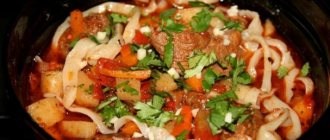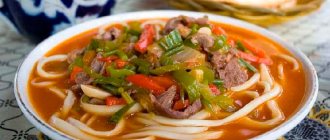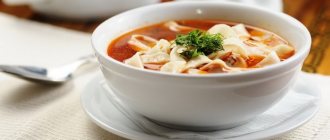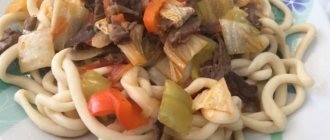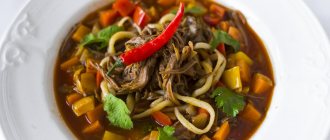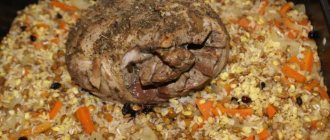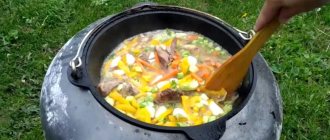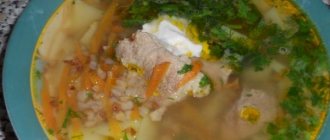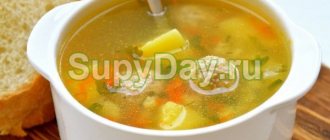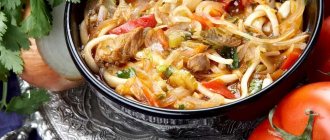The dish is called Uyghur lagman because the Uyghurs brought the recipe to Central Asia, which is the birthplace of lagman.
In China, lagman symbolizes love and relationships; in the East, lagman is often prepared together. Let's look at several recipes for preparing Uyghur lagman at home. Do you like lagman?
- Yes 98%, 46 votes
46 votes 98%46 votes - 98% of all votes
- No 2%, 1 vote
1 vote 2%
1 vote - 2% of all votes
Total votes: 47
19.04.2020
Tayerlash
It's easy to prepare tayerlash, you need:
- Beef 300 g;
- Flour 200 g;
- Green beans 4 pods;
- Garlic 3 cloves;
- Tomato;
- Celery 3 stalks;
- Green onions 3 stalks;
- Half a radish;
- Eggplant;
- Red pepper, bell pepper;
- Ground coriander;
- Chopped cilantro.
Cooking time for the recipe is one and a half hours.
Step by step recipe:
- Sift the flour thoroughly, add a little salt, add warm water. After kneading the dough, roll it into a ball, wrap it in cling film and put it in the refrigerator for 1 hour. After time has passed, knead the dough again and roll it into a rope. Cut it into strips whose thickness should not exceed the thickness of a finger. Roll each piece into ropes, coat with vegetable oil, and leave in this form for 30 minutes.
- Pull the resulting flagella from the dough into noodles; the length should be approximately 1 m. Boil water in a large saucepan, salt it, and add the noodles. When cooked, place in a colander to drain excess moisture. Pour in vegetable oil, mix thoroughly, leave to cool.
- Grind 2 cloves of garlic, add ground coriander, hot pepper and chopped cilantro. Add salt and place in a greased frying pan already heated over high heat. Stir quickly and immediately remove from heat.
- Heat oil in a cauldron, fry chopped onion and garlic, bean pods. Add salt, coriander, add half of the fried meat, cut into small cubes, fry for 2 minutes. Again I added salt and coriander, small cubes of eggplant, and radish. Fry until done, add a ladle of noodle broth. Stir thoroughly; when it boils, place in a bowl and cover tightly.
- Fry the remaining meat, add salt, coriander, garlic and onion. Cut the bell pepper into half rings, add to the meat, simmer for 2 minutes. Coarsely chop the tomatoes, remove the skins and cook until the liquid has evaporated.
- Add a ladle of noodle broth, cilantro, mix thoroughly. When it boils, place in a separate plate and cover with a lid. Pour boiling water over the noodles.
Everything is placed on the table separately, people themselves add the noodles and the necessary lagman dressing for it.
Caloric content of lagman is 1800 kcal, 120 g of protein, 200 g of carbohydrates.
Recipe for making dough for Uyghur lagman
Perhaps the most difficult step for beginners in preparing this dish is making the dough correctly. However, once you master this whole process, everything will go like clockwork.
By the way, some sources contain information that the name “lagman” comes from the word “lamyan”, meaning “stretched dough”. Whether this is true or not, I will not say unequivocally. Instead, I’ll tell you a step-by-step recipe to help you properly prepare manual dough for lagman.
What you will need:
- flour 1 kg
- egg 1 piece
- water 2 glasses
- salt 1 tbsp
- salt 1 tbsp
- vegetable oil 2-3 tbsp
Preparation:
- First of all, sift the flour. This will reduce the risk of foreign bodies being introduced into the dough during the production process. And the flour will become looser, so it will be easier for you to knead the dough. Then place the egg in a bowl with the sifted flour.
- Heat the water to 35-37 degrees and dissolve the salt in it. Next, gradually add water to the flour and mix the ingredients until smooth.
- Please note: continue kneading the dough until it becomes soft and pliable.
- Roll it into a bun, cover with a bowl or cling film and leave for 45-50 minutes.
- The settled bun became soft and pliable. Lubricate your palms with oil and gently stretch it with your hands into an oval cake. Then we cut this layer into strips approximately 2 cm thick.
- Grease your palms again and begin to stretch out the dough. We work with each piece separately. First we give it the shape of a cylinder. Then we roll it out onto the table into flagella with our hands.
- You need to roll out the dough in stages. That is, first, all the pieces were brought to approximately the same diameter, then we begin to roll out the flagella in a second circle, reducing their diameter.
- Place a bowl of vegetable oil nearby and lubricate your hands with it constantly.
- And we do this 3 times. As a result, the thickness of the flagella should be as thick as a little finger (or maybe less).
- Try to roll out the dough very quickly. Otherwise, it will dry out and nothing will come of it.
- And while the rolled out dough is waiting in the wings, cover it with a plastic bag: this will slow down the drying process.
- We roll the rolled flagella into a spiral. This dough can be placed on a flat plate, covered with cling film on top and placed in the refrigerator. Here it can be stored for 2-3 days.
- And if you put the product in the freezer, you can increase its shelf life to up to a month. All you need to do next is take out the dough and let it thaw for an hour at room temperature. And then you can safely make noodles.
- If you expect a lot of guests and you think that you need to cook from the entire dough, just roll the flagella into a spiral in a bowl. Cover and set aside for half an hour.
- Let's start pulling out the noodles. Take the dough with 2-3 fingers and gently pull it into threads. Use your fingers to gently twist the threads. As a result, they should be approximately 5 mm thick.
- Then we begin to wind the threads on both hands (this is something like in childhood, when you played with threads). Next, we pull the dough - lift it and sharply lower it onto the table (do this 2-3 times).
- Place the finished noodles in small batches into boiling salted water.
- Do not skimp on liquid, pour more of it so that the pasta does not stick together during cooking.
- Gently stir with a fork and cook for about 4-5 minutes. Remove to a colander and rinse with cold water. This will help prevent the noodles from overcooking, as they can still “cook” at their own temperature.
Place the finished dish in a bowl and place in a cool place. Here it can stand for a couple of hours without losing its taste. Before serving, place into serving bowls.
Guiru
For this recipe for Uyghur lagman you need:
- Beef 300 g;
- Radish;
- Onion;
- Bell pepper;
- Green beans;
- Garlic;
- Tomato;
- Dough;
- Vegetable oil.
Cooking time: hour.
- According to the recipe, initially chop the radish, sprinkle generously with salt, and add water. This will remove the unpleasant odor and preserve the taste. Heat oil in a frying pan, cut the meat into pieces, add, fry until the juices evaporate. Next, finely chop the onion and add to the meat. As soon as it is fried a little, then add radish, pepper, and beans. Mix the contents thoroughly as you add ingredients.
- When the vegetables are almost ready, add the chopped tomatoes and simmer for a couple of minutes. Next, pour water and wait for it to boil. Add salt, reduce heat to low, add chopped garlic cloves, fresh herbs, cook lagman guira for 5 minutes.
- Cut the dough into strips and make flagella from the strips. Roll the flagella into balls and dip in vegetable oil. Gently stretch each flagellum into noodles. Pour water into a large saucepan and add a lot of salt. When it boils, add the noodles. When the water and the noodles are already boiling, you need to remove the pan from the heat, drain the water, rinse the noodles thoroughly, and put them in the pan. Pour in oil and mix thoroughly.
The calorie content of the recipe is 1600 kcal, 90 g protein, 70 g fat, 140 g carbohydrates.
How to cook Uyghur lagman with beef
Beef is considered a healthier meat than lamb because it is less fatty. But this does not affect the taste of lagman at all - it turns out just as satisfying and appetizing.
Products:
- ready noodles - 400 g;
- beef tenderloin – 0.3 kg;
- potato tubers – 2 pcs.;
- medium blue;
- pepper – 1 pc.;
- tomato;
- black radish – 100 gr;
- parsley - a bunch;
- oregano – 1 tsp;
- salt and seasonings to taste;
- fat - 50-60 gr.
Time spent: 1 hour.
Calories: 250.
Preparation:
- Grind the meat into pieces of 2-3 cm;
- Melt the fat in a cauldron and fry the meat in it;
- Pour water over the meat and simmer for five minutes;
- Peel all vegetables;
- Throw the potatoes into the cauldron;
- Grate the radish, cut the potatoes into strips, the eggplant and tomato into cubes, and the pepper into thin strips;
- When the potatoes become soft, add radish and eggplant;
- Fry the tomatoes and peppers separately and throw them into the cauldron 7 minutes after the radishes;
- Finely chop the greens and add to the cauldron along with all the seasonings at the end of stewing;
- Remove the cauldron from the heat and let it brew;
- Mix the sauce with the noodles pre-cooked in salted water and serve!
Pizza with tomatoes, sausage and cheese - the simplest recipes for this Italian dish, in different variations.
Read our article on how to cook a sponge cake without eggs in a slow cooker.
Do you know how to make cottage cheese cookies without butter and margarine? We have collected several recipes.
Fried
Fried lagman recipe is unusual, outstanding for its taste.
You will need:
- Beef 300 g;
- Onion;
- Carrots 200 g;
- Bulgarian pepper 200 g;
- Chilli;
- Chicken eggs 2 pcs;
- Greenery;
- Pasta;
- Vegetable oil;
- Tomato paste.
It's getting ready for an hour.
- Cut the meat into cubes, heat the frying pan with vegetable oil, add the meat, fry for 20 minutes over medium heat. Cut the vegetables into small pieces, then add onions, carrots, and bell peppers to the pan step by step. You need to wait 2 minutes between ingredients, stirring regularly.
- Salt, pepper, add spices. Add tomato paste, stir, simmer until all the liquid has evaporated.
- According to the recipe, cook the pasta separately, then add it to the fryer and mix thoroughly. In a separate frying pan, beat the eggs and make an omelette. Then just cut it into pieces. When serving the dish, the omelette is laid out in pieces on top, then fresh herbs are crumbled, the real fried lagman is ready.
The calorie content of this lagman recipe is 1500 kcal, 90 g protein, 80 g fat, 140 g carbohydrates.
Classic gravy guira sai at home
The name of the gravy for lagmans may vary. In Central Asia, the sauce is called vaja, and among the Uyghurs it is called sai. It is not difficult to prepare, although there are a lot of ingredients. And it turns out simply amazing.
What you will need:
- Meat - lamb or beef - at least 500 g (however, the more the better)
- Chopped ginger - a little
- Ground coriander - a little
- Salt - to taste
- Khazhu pepper (it can be replaced with ground black) – on the tip of a knife
- Red and green bell peppers – 1 pc.
- Red hot pepper – 1 pc.
- Dungan radish or daikon – ½ medium root vegetable
- Onions – 2-3 pcs.
- Chinese cabbage – 1/3 head (you need a hard core)
- Leaf celery – 2-3 leaves
- Garlic – 4-5 cloves
- Green bean pods – 5-6 pcs.
- Wild garlic or garlic feathers – 4-5 pcs.
- Tomatoes - 3-4 medium fruits (if you take cherry tomatoes, you will need 6-7 of them)
- Vegetable oil - for frying
- Star anise – 1 star
- Water (broth) - glass
Preparation::
- To prepare the gravy, choose lean pulp. Cut the meat into rectangular pieces measuring 2-4 cm. Their thickness should not exceed 5-7 mm. Next, marinate the meat. Season it with salt, add some chopped coriander and khazhu.
- We clean the bell pepper from stalks and seeds. Then wash and cut into small slices. If you like it spicy, wash the chili pepper and cut it into thin rings. If you don’t like spicy food, you can make the gravy without chili.
- Wash the radish and cut into cubes. Peel the onion, wash it and cut it into thin half rings or quarters.
- We wash the cabbage and cut its hard part into thin pieces.
- By the way, you can then use the remaining soft leaves to prepare a vegetable salad.
- Yes. In lagman, it is the hard part of the cabbage leaf, the very core, that is used.
- We do the same with celery. We wash and separate the leaf part from the stems. Set the greens aside and cut the stems into 2-2.5 cm pieces.
- Peel the garlic. Then we wash it and finely chop it with a knife. We wash the green beans and wild garlic or garlic feathers, and then chop them with a knife.
- We wash the tomatoes. Cut them into large slices. And also, if you wish, you can remove the skin from the tomatoes.
- If you have small cherry tomatoes, simply cut them into halves.
- So, when all the vegetables are chopped, we begin to prepare the gravy. Heat up a cauldron or deep, thick-bottomed frying pan. Pour vegetable oil into it (pour enough so that you can fry the meat and onions in it). The fire must be strong.
- Throw the star anise into the heated vegetable oil. This spice will give the oil a unique taste and amazing aroma. Fry the star anise until the star turns black. Then remove the star anise from the oil and add the meat to it. Fry it over high heat until golden brown. Next, add onion to the meat and fry it too.
- Then add other vegetables. Each with an interval of 3-4 minutes. The recommended order is as follows: celery stalks, tomatoes, garlic, green beans, wild garlic, radishes, bell peppers and Chinese cabbage. Mix all ingredients well. Pour the broth over it all and simmer until the vegetables are ready.
- It’s difficult to say exactly when it comes to time: be guided by the fact that the vegetables should not be boiled.
- Chop the celery greens: they will be used for sprinkling on plates. Essentially, the guiru sai is ready. You can call guests to the table. Uyghur lagman is served as follows: put noodles on a plate, put sai on top and sprinkle with chopped herbs.
Vaji gravy
Separately, you can prepare gravy for the lagman. For it you will need:
- Lamb 400 g;
- Tomatoes 400 g;
- Onion;
- Potatoes 200 g;
- Bell pepper;
- Greenery;
- Garlic;
- Salt, pepper, spices;
- Hot pepper.
Prepare according to recipe in 45 minutes.
- Place lamb fat in a cauldron, melt it, and fry the lamb, cut into small pieces, on it. When ready, turn down the heat and add chopped onions, carrots and peppers on top.
- When the vegetables are browned, peel and cut the potatoes into cubes and place on top. Salt, pepper, add spices. Add a little water, reduce heat to low. Simmer lagman for 15 minutes.
- According to the recipe, grind fresh herbs, hot peppers and garlic in a mortar and mix. After 15 minutes, add chopped tomato and spicy mortar dressing to the gravy.
Calorie content of lagman is 1100 kcal, 80 g protein, 70 g fat, 30 g carbohydrates.
How to cook “Laghman in Uyghur style”
Vazha (gravy) Beef pulp 300 g Zira (Cumin) ground 0.5 tsp. Fresh cilantro 5 sprigs Ground coriander 0.5 tsp. Green onion 2 feathers Onion 1 pc. Sesame oil 60 ml Carrots 1 pc. Dungan pepper 1 pc. Ground black pepper 1 pinch Fresh parsley 5 sprigs Tomatoes 2 pcs. Green radish 1 pc. Extra salt 1 tsp. Garlic arrows 100 g Tomato paste 0.5 tbsp. l. Fresh green beans 100 g Garlic 2 cloves Laza (seasoning) Ground coriander 1 tsp. Sesame oil 2 tbsp. l. Ground red pepper 1 tsp. Salt 1 pinch Apple vinegar 1 tbsp. l. Garlic 3 cloves Noodles Water 1.5 l Homemade pulled noodles 300 g
Preparation:
- To prepare lagman we will need the following products: homemade pulled noodles, beef meat, onions, green onions, Dungan peppers, green radishes, carrots, green beans, garlic arrows or jusai, tomatoes, herbs, vegetable oil, spices.
- We're preparing the gravy - it's important. Cut the meat into small pieces and fry in well-heated oil. It is believed that boned meat must be added to lagman. I usually do this, but today I prepared a small amount of lagman, so I didn’t add the seeds, but you should keep this in mind.
- Add thinly sliced onion to the fried meat. Fry for 10 minutes until golden brown.
- Finely chop the tomatoes, mix with tomato paste and garlic. Stir and let it brew.
- Combine the meat with tomatoes, add salt, and fry everything together until the liquid boils away. If the tomatoes are sour, add a little sugar.
- Cut the radish, pepper and carrots into thin strips. In Uyghur lagman, cutting matters.
- Cut the garlic arrows and green beans into pieces.
- Add all the vegetables to the tomatoes and meat. You can do this gradually, but then the vegetables will be too overcooked. In the Uyghur lagman, vegetables should not be overcooked and they should not be completely soft. Vegetables should remain, as they say, “al dente”. Fry everything together for 5 minutes, add salt and pepper to taste.
- It's time to add water. It is better to use the water in which the noodles were cooked. Since I already have ready-made noodles, I can add regular boiling water so that it covers all the vegetables. Please note that this is not a soup and the vazha should remain thick. Bring to a boil and cook the gravy for another 10-15 minutes until the liquid boils slightly.
- Add spices - ground coriander, chopped garlic, cumin, pepper, herbs. After a minute, turn off the heat and let it brew for 10 minutes.
- Place the prepared pulled noodles in boiling water and warm before serving. If you don’t have ready-made pulled noodles, you can try using the thinnest pasta, with a hole inside, and boil them until tender, but the taste will be different. The dough for pulled noodles is greased with a solution of salt, soda and oil during stretching, so the finished product is very easy to scoop with a spoon and does not break.
- Lagman is unthinkable without seasoning - laza. To prepare it, you need to heat a little sesame (vegetable) oil, add chopped garlic, coriander and red pepper. Warm all the spices slightly so that they release their aroma, do not fry. Season well with salt and vinegar. The seasoning is ready.
- Pour a little gravy into the casa, add the noodles, then add the gravy again, sprinkle with herbs and serve with seasoning. Add the seasoning to your plates as desired.
How to cook noodles
For the noodles for lagman you will need:
- Flour;
- Chicken eggs;
- Salt;
- Water;
- Vegetable oil.
Cooking time is one and a half hours.
- Prepare the dough: sift the flour thoroughly, add salt, mix. Pour into a container, pour in 2 chicken eggs, salt, add water, mix thoroughly. You will get a thick dough. Mash it thoroughly, then roll it into a ball and wrap it in cling film. Place in the refrigerator for an hour. After time has passed, take out the dough, knead it thoroughly again, and roll it into a large circle.
- Cut thin lines from the circle, make flagella, roll the flagella into rolls. Blot each roll in vegetable oil and let sit for 5 minutes. While cooking, put a large pot of water to boil and add a lot of salt. At this time, you need to start pulling noodles out of each roll. Place in boiling water and stir. When your noodles boil, drain the water. Pour vegetable oil into the noodles, mix thoroughly so that they do not stick together, noodles for lagman.
The calorie content of this lagman recipe is 700 kcal, 10 g protein, 7 g fat, 400 g carbohydrates.
Chuzma stretching
Uyghur lagman differs from other varieties of this dish in the interesting taste of noodles. But you'll have to tinker with it. Within half an hour, our flagella were saturated with vegetable oil and became very elastic. We check their ability to stretch. We take one flagellum in our left hand, and with the fingers of our right we pull it by the tip. If the dough is still cool and the rope is about to break, wait a little longer. And if the flagellum stretches well, we continue working. We intercept the rope with the fingers of our right hand closer to the opposite tip and twist the thread. We place the resulting packages in the same dish, greasy with oil, but so that we do not lose the edge of the pasta. Experienced Uighur-style lagman cooks can pull spaghetti two meters long from a piece of dough! The first two noodles will make you sweat, but then the work will begin to progress.
Description of preparation:
It is best to check such fried lagman at home during cooking periodically - the noodles, for example, should be immersed in juices constantly, so if something happens, add water in small portions.
This recipe for making fried lagman, apart from this, does not contain any complicated steps, everything is as simple as two! Therefore, I recommend that you prepare it as soon as possible, even for lunch or dinner! Purpose: For lunch / Inexpensive Main ingredient: Meat / Vegetables / Lamb / Legumes / Beans / Tomato Dish: Hot dishes Geography of cuisine: Uzbek
